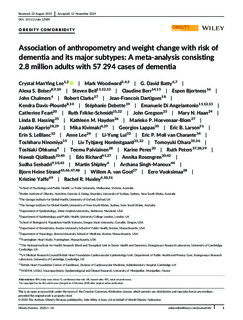| dc.contributor.author | Lee, Crystal Man Ying | |
| dc.contributor.author | Woodward, Mark | |
| dc.contributor.author | Batty, G. David | |
| dc.contributor.author | Beiser, Alexa S. | |
| dc.contributor.author | Bell, Steven | |
| dc.contributor.author | Berr, Claudine | |
| dc.contributor.author | Bjertness, Espen | |
| dc.contributor.author | Chalmers, John | |
| dc.contributor.author | Clarke, Robert | |
| dc.contributor.author | Dartigues, Jean-Francois | |
| dc.contributor.author | Davis-Plourde, Kendra | |
| dc.contributor.author | Debette, Stéphanie | |
| dc.contributor.author | Di Angelantonio, Emanuele | |
| dc.contributor.author | Feart, Catherine | |
| dc.contributor.author | Frikke-Schmidt, Ruth | |
| dc.contributor.author | Gregson, John | |
| dc.contributor.author | Haan, Mary | |
| dc.contributor.author | Hassing, Linda B. | |
| dc.contributor.author | Hayden, Kathleen M. | |
| dc.contributor.author | Hoevenaar-Blom, Marieke P. | |
| dc.contributor.author | Kaprio, Jaakko | |
| dc.contributor.author | Kivimaki, Mika | |
| dc.contributor.author | Lappas, Georgios | |
| dc.contributor.author | Larson, Eric B. | |
| dc.contributor.author | LeBlanc, Erin S. | |
| dc.contributor.author | Lee, Anne | |
| dc.contributor.author | Lui, Li-Yung | |
| dc.contributor.author | van Charante, Eric P. Moll | |
| dc.contributor.author | Ninomiya, Toshiharu | |
| dc.contributor.author | Nordestgaard, Liv Tybjærg | |
| dc.contributor.author | Ohara, Tomoyuki | |
| dc.contributor.author | Ohkuma, Toshiaki | |
| dc.contributor.author | Palviainen, Teemu | |
| dc.contributor.author | Peres, Karine | |
| dc.contributor.author | Peters, Ruth | |
| dc.contributor.author | Qizilbash, Nawab | |
| dc.contributor.author | Richard, Edo | |
| dc.contributor.author | Rosengren, Annika | |
| dc.contributor.author | Seshadri, Sudha | |
| dc.contributor.author | Shipley, Martin | |
| dc.contributor.author | Sing-Manoux, Archana | |
| dc.contributor.author | Strand, Bjørn Heine | |
| dc.contributor.author | van Gool, Willem A. | |
| dc.contributor.author | Vuoksimaa, Eero | |
| dc.contributor.author | Yaffe, Kristine | |
| dc.contributor.author | Huxley, Rachel R. | |
| dc.date.accessioned | 2020-02-12T08:35:34Z | |
| dc.date.available | 2020-02-12T08:35:34Z | |
| dc.date.created | 2020-01-15T09:03:01Z | |
| dc.date.issued | 2020 | |
| dc.identifier.issn | 1467-7881 | |
| dc.identifier.uri | http://hdl.handle.net/11250/2641193 | |
| dc.description.abstract | Uncertainty exists regarding the relation of body size and weight change with dementia risk. As populations continue to age and the global obesity epidemic shows no sign of waning, reliable quantification of such associations is important. We examined the relationship of body mass index, waist circumference, and annual percent weight change with risk of dementia and its subtypes by pooling data from 19 prospective cohort studies and four clinical trials using meta‐analysis. Compared with body mass index–defined lower‐normal weight (18.5‐22.4 kg/m2), the risk of all‐cause dementia was higher among underweight individuals but lower among those with upper‐normal (22.5‐24.9 kg/m2) levels. Obesity was associated with higher risk in vascular dementia. Similarly, relative to the lowest fifth of waist circumference, those in the highest fifth had nonsignificant higher vascular dementia risk. Weight loss was associated with higher all‐cause dementia risk relative to weight maintenance. Weight gain was weakly associated with higher vascular dementia risk. The relationship between body size, weight change, and dementia is complex and exhibits non‐linear associations depending on dementia subtype under scrutiny. Weight loss was associated with an elevated risk most likely due to reverse causality and/or pathophysiological changes in the brain, although the latter remains speculative. | |
| dc.language.iso | eng | |
| dc.title | Association of anthropometry and weight change with risk of dementia and its major subtypes: A meta‐analysis consisting 2.8 million adults with 57 294 cases of dementia | |
| dc.type | Peer reviewed | |
| dc.type | Journal article | |
| dc.description.version | publishedVersion | |
| dc.source.journal | Obesity Reviews | |
| dc.identifier.doi | 10.1111/obr.12989 | |
| dc.identifier.cristin | 1773285 | |
| cristin.unitcode | 7502,3,2,0 | |
| cristin.unitname | Avdeling for kroniske sykdommer og aldring | |
| cristin.ispublished | true | |
| cristin.fulltext | original | |
| cristin.qualitycode | 1 | |
